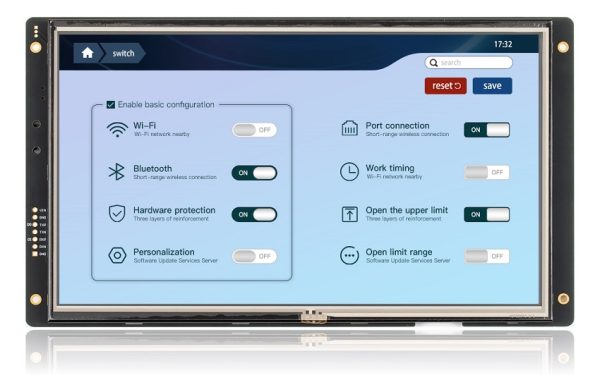由于其高分辨率、可靠性和多功能性,组态屏在机械和汽车中的应用越来越广泛。本文探讨了组态屏在这些特定应用中的技术特点和优势。

组态屏技术概述
组态屏是一种液晶显示器(LCD),通过薄膜晶体管技术提升图像质量和响应速度。该屏幕由多层结构组成,包括偏光片、液晶分子层和颜色滤光片,每个像素由独立的晶体管控制的解决方案。
在机械设备中的优势
在机械设备领域,组态屏具备多项优势。它们能清晰显示操作数据,如设备状态、性能指标和诊断信息。高分辨率确保操作人员能精准监控流程,从而提升整体生产效率。此外,组态屏结构坚固,可承受严苛的工业环境,包括粉尘、振动和温度波动。
增强的耐用性和可靠性
组态屏适合机械应用的关键特征之一是其耐用性。屏幕设计可连续运行而不影响性能,确保长时间可靠运行。这种可靠性在工业环境中至关重要,因为停机时间可能导致高昂成本和生产中断。
与控制系统集成
组态屏可无缝集成到机械中使用的各种控制系统。它们可实时显示传感器和执行器采集的数据,使操作人员能够迅速做出明智决策。这种集成显著提升了工业流程的整体效率和安全性。
汽车应用
在汽车行业,组态屏被广泛应用于仪表盘、信息娱乐系统及平视显示器(HUD)。这些屏幕以直观易读的格式向驾驶员提供车速、导航指示及多媒体内容等关键信息。
高分辨率显示屏提升清晰度
现代汽车需要在各种光线条件下都能提供高分辨率和清晰度的显示屏。组态屏通过呈现清晰锐利的图像和生动色彩,满足这一需求,从而提升车内用户的体验。
自适应显示技术
部分组态屏集成了自适应显示技术,可根据环境光线条件动态调节亮度和对比度。这确保了最佳可视性,避免驾驶员因光线变化而分心或感到不适,从而提升道路安全。
串口屏对设计的影响
串口屏的采用也影响了汽车设计。制造商现在可以通过将这些平板显示屏集成到仪表盘布局中,打造时尚前卫的内饰。这一趋势不仅提升了美观性,还向消费者展示了技术进步。
未来趋势与创新
展望未来,组态屏在机械和汽车领域的应用前景光明。柔性TFT显示屏和有机发光二极管(OLED)技术等创新将进一步革命性地提升显示性能,带来更薄的屏幕和更高的能效。
结论
综上所述,组态屏在提升机械和汽车的功能性和用户体验方面发挥着至关重要的作用。其高分辨率、耐用性和集成能力使其在现代工业和汽车应用中不可或缺。随着技术持续演进,串口屏有望继续引领显示技术创新,推动各行业生产力与创新发展。
通过探索这些技术特性与优势,不难发现 串口屏 不仅是一种显示技术,更是现代工业与汽车设计的核心基石。